 |
 |
 |
| |
Safety and antiviral activity of TMC435350 in treatment-naive genotype 1 HCV-infected patients
|
| |
| |
Reported by Jules Levin
AASLD Nov 3 2008 San Francisco, CA
M. Manns1, H. Reesink2, C. Moreno3, T. Berg4, Y. Benhamou5, Y. Horsmans6, G. Dusheiko7, R. Flisiak8, P. Meyvisch9, O. Lenz9, K. Simmen9, R. Verloes9
1Medizinische Hochschule Hannover, Germany; 2Principal Investigator; Academic Medical Center, Amsterdam, The Netherlands; 3Erasme Hospital, Universite Libre de Bruxelles, Belgium; 4Charite-Universitätsmedizin Berlin, Campus Virchow-Klinikum, Germany; 5Centre Hospitalier Universitaire Pitie-Salpetriere, Paris, France; 6Saint-Luc Universite Catholique de Louvain, Belgium; 7Royal Free Hospital, London, UK; 8Medical University of Bialystok, Poland; 9Tibotec BVBA, Mechelen, Belgium.
AUTHOR SUMMARY
TMC435, at doses of 25 and 75 mg QD was well tolerated in combination with PegIFNβ-2a/RBV in treatment-naive HCV genotype 1 patients for up to 28 days.
All AEs possibly related to TMC435 were mild to moderate in severity (grade 1-2).
Mean reductions of HCV-RNA from baseline at day 7 with TMC435 alone (panel A) and combined with PegIFNβ-2a/RBV (panel B) were 2.63 and 3.47 Log10 IU/mL, respectively, in the 25 mg dose group, and 3.43 and 4.55 Log10 IU/mL, respectively, in the 75 mg dose group.
In the 75 mg 4-week triple therapy arm (panel B), no viral breakthrough was observed and 9/9 patients achieved HCV-RNA levels below LLQ (<25 IU/mL) and 8/9 patients achieved undetectable HCV-RNA (<10 IU/mL) at day 28 (RVR=89%).
AUTHOR CONCLUSIONS
In cohort 1 of the OPERA-1 study, 25 mg and 75 mg TMC435 administered once-daily in com-bination with standard of care (PegIFNβ-2a/RBV), demonstrated dose-dependent potent antiviral activity and a favorable safety and tolerability profile up to 28 days of dosing in treatment-naive, chronic hepatitis C patients with genotype 1.
A 200 mg dose group of TMC 435 is now being evaluated in patients of cohort 2 of the OPERA-1 study.
INTRODUCTION
Activity of the HCV serine protease NS3/4A is essential for viral replication (Figure 1).
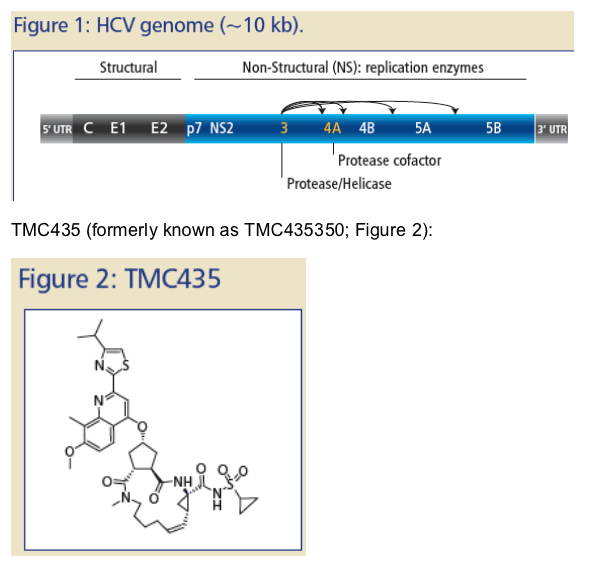
Macrocyclic HCV NS3/4A protease inhibitor
Potent ⋅ in vitro activity against genotype 1a and 1b derived NS3/4A enzymes and replicon cell lines
EC⋅ 50 = 8 nM (genotype 1b replicon)
~2-fold shift of EC⋅ 50 value in the presence of plasma proteins
High liver to plasma ratio (>30 fold in pre-clinical ⋅ studies)
OPERA-1 (TMC435-C201):
A double blind, placebo-controlled, Phase IIa proof-⋅ of-concept trial, to assess antiviral activity, safety and pharmacokinetics (PK) of once-daily (QD) regimens of TMC435 in HCV genotype-1 infected treatment-naive and treatment experienced (prior non-responders, relapsers or breakthroughs to IFN based therapy) patients.
Interim results of the first 28 days of treatment from ⋅ the first cohort of treatment naive patients (25 or 75 mg TMC435 versus placebo) are reported here.
This study follows the Phase I trial in healthy ⋅ volunteers showing safety and good tolerability at single doses up to 600 mg and repeated doses of 400 mg for 5 days. This Phase I trial also included a genotype 1 patient arm of previous non-responders/relapsers to IFN-based therapy dosed at 200 mg QD for 5 days.(1, 2)
METHODS
OPERA-1 trial design (Figure 3)
In cohort 1, patients were randomized to receive either:
-- 7 days of monotherapy of TMC435, 25 or 75 mg QD, or placebo followed by 21 days of triple therapy with TMC435 or placebo, PegIFNβ-2a (180 μg subcutaneous once-weekly) and ribavirin (RBV; 1000-1200 mg daily) (Panel A);
-- or 28 days of triple therapy with TMC435 (25 or 75 ⋅ mg QD) or placebo, PegIFNβ-2a and RBV (Panel B).
After day 28, patients continued on PegIFNβ-2a/RBV for a total of 24 or 48 weeks, at the discretion of the Investigator.

To study the dose dependency of the antiviral effect of 2 doses of TMC435 QD during 1 week of mono-therapy in HCV treatment-naive patients.
To study the dose dependency of the antiviral effect of 2 doses of TMC435 QD during combined triple therapy with PegIFNβ-2a and RBV in HCV treatment-naive patients.
To determine safety, tolerability and PK profile of TMC435 QD during 7 days of monotherapy and combined with PegIFNβ-2a and RBV for 21 or 28 days.
RESULTS
Patients
Demographics are shown in Table 1.
50 patients were randomized and started treatment.
All patients completed the 4-week treatment period.
All patients were continued on PegIFN⋅ _-2a/RBV after day 28.
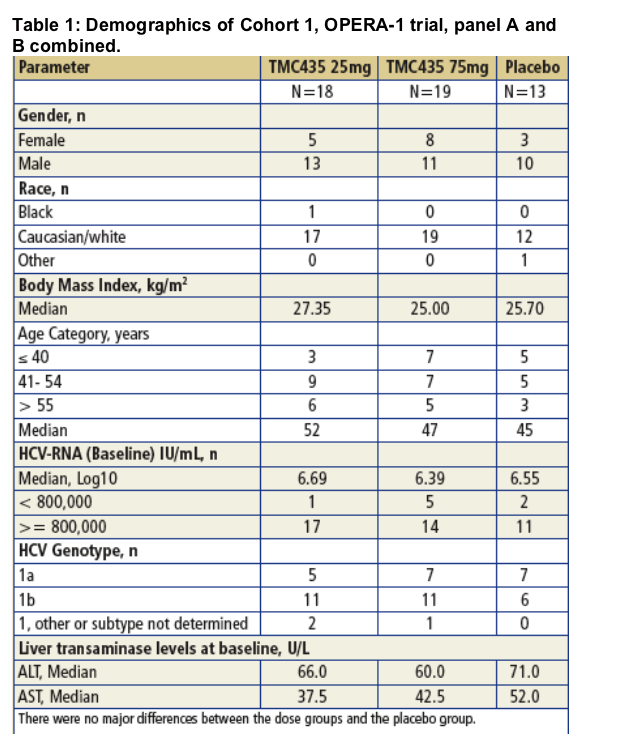
Pharmacokinetics
The mean steady-state plasma Cmin values (± standard deviation) of TMC435 were 71 ± 51 ng/mL for the 25 mg QD regimen, and 266 ± 159 ng/mL for the 75 mg QD regimen, 12 to 44-fold in excess of the EC50 for genotype 1 HCV.
Full PK results for Panel A and B are presented in a ⋅ separate poster by Van't Klooster et al.(3)Full PK results for Panel A and B are presented in a ⋅ separate poster by Van't Klooster et al.(3)
Safety
Adverse events are shown in Table 2.
No dose-related safety findings.
No treatment-discontinuations due to TMC435-related safety or lab abnormalities.
All TMC435 possibly related adverse events (AEs) were mild or moderate in severity (grade 1 or 2); no grade 3 or 4 AEs at least possibly related to TMC435.
The most common AEs considered related to TMC435 ⋅ treatment were headache, nausea and diarrhea.
No clinically significant findings on laboratory parameters, including liver function (Figure 4), vital signs, ECG or physical examination.
The safety analysis showed that doses of 25 and 75 mg were generally safe and well tolerated and allowed dosing of the next cohort (200 mg QD).
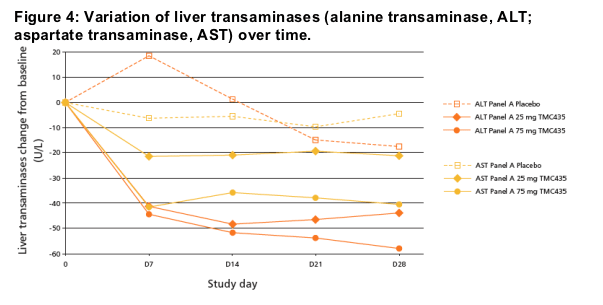
Antiviral Activity
Change in HCV RNA levels in the first 4 weeks of therapy is shown in Figure 5.
25 mg and 75 mg QD of TMC435 plus PegIFNβ-2a/RBV resulted in greater mean HCV RNA reduction than PegIFNβ-2a/RBV alone.
Mean Reduction of HCV RNA from baseline at day 7 in the 75 mg dose groups (3.43 and 4.55 Log10 IU/mL for panel A and B, respectively) was greater than in the corresponding 25 mg dose groups (2.63 and 3.47 Log10 IU/mL for panel A and B, respectively).
Addition of PegIFNβ-2a/RBV to TMC435 increased the mean HCV RNA reduction at day 7 by 0.84 and 1.12 Log10 IU/mL for 25 mg and 75 mg dose groups, respectively.
During the first 28 days of treatment, 2 viral break-throughs (defined as >1 Log10 IU/mL increase of HCV RNA from nadir) in the 25 mg and 75 mg dose groups of panel A were observed, respectively. No viral breakthrough was noted in panel B. Sequence analysis is in progress.
In the 25 mg 4-week triple therapy arm, 6/9 patients achieved HCV RNA below lower limit of quantifica-tion (LLQ) (<25 IU/mL) and 3/9 patients were below lower limit of detection (LLD) (<10 IU/mL) at day 28 (rapid viral response, RVR = 33%).
In the 75 mg 4-week triple therapy arm, 9/9 patients were below LLQ and 8/9 patients achieved undetect-able HCV RNA (< LLD) at day 28 (RVR=89%).
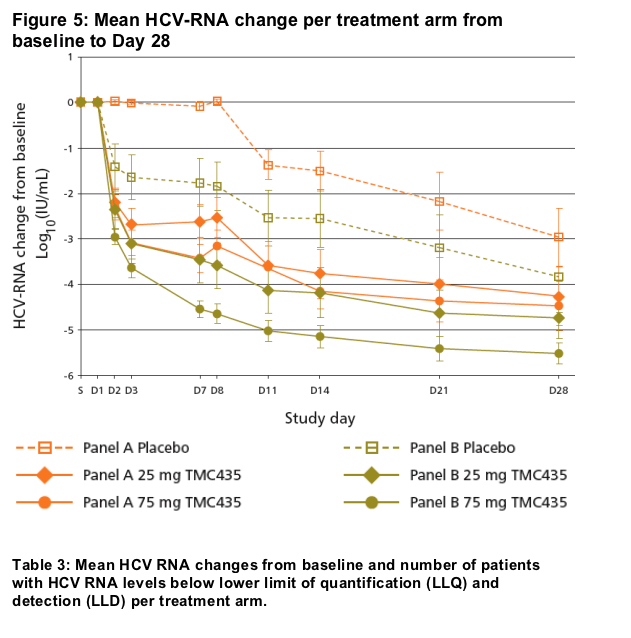
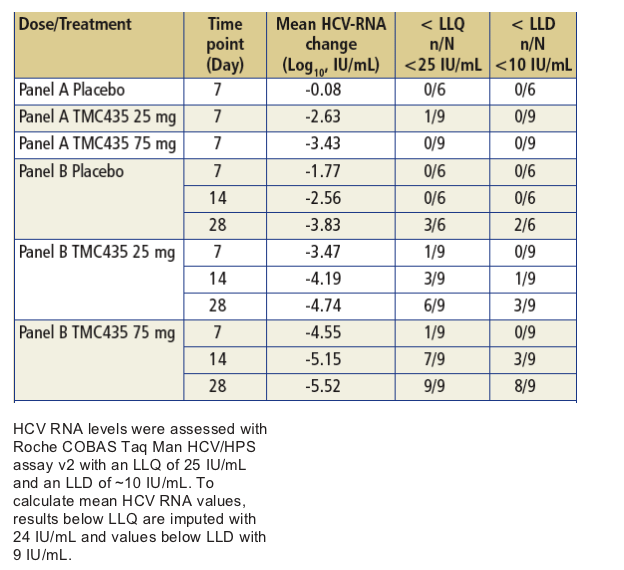
REFERENCES
1. Verloes R et al., 58th AASLD, Boston, MA, November 2-6, 2007, Poster 1318. 2.
Reesink H et al., 43rd EASL, Milan, Italy, April 23-27, 2008, Oral Presentation.
3. Van't Klooster et al., 59th AASLD, San Francisco, CA, October 31 - November 4, 2008, Poster 1895.
|
| |
|
 |
 |
|
|